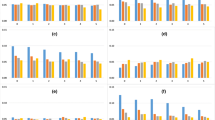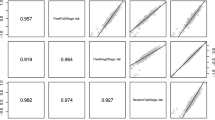Abstract
Shrinkage factors applied to the additive main effects and multiplicative interaction (AMMI) models improve prediction of cultivar responses in multi-environment trials (MET). Estimates of shrinkage factors based on the eigenvalue partition (EVP) method may get a further improvement in the predictions of cell means. Objectives of this work were: (1) to compare the EVP-based shrinkage method with unshrunken AMMI, best linear unbiased predictor (BLUP) and other shrunken method (herein named CCC), when they were applied to five maize MET and simulation data; (2) to assess by cross validation the equation which estimates the standard error of predicted means (SEPM) based on the EVP theory; (3) to estimate the genotype × environment interaction (GEI) variance components after applying the EVP shrinkage method to the five maize MET. Empirical data of five maize MET and simulation data were used for cross validation of the methods using the root mean square predictive difference (RMSPD) criterion. The RMSPD of the shrunken EVP predicted cell means was generally smaller than those of the other methods, suggesting that the EVP method was generally better predictor than the other methods. The truncated AMMI was the worst among the four methods studied. The EVP-based equation, which predicts the SEPM, was a good predictor as determined by the RMSPD cross validation criterion, with the advantage that it does not need one replication for validation. Estimates of mean squares, and GEI and error variances associated with the GEI effects were smaller for the shrunken EVP predicted effects than for the original data.
Similar content being viewed by others
References
Cornelius, P.L., 1993. Statistical tests and retention of terms in the additive main effects and multiplicative interaction model for cultivar trials. Crop Sci 33:1186–1193.
Cornelius, P.L., J. Crossa & M.S. Sayedsadr, 1993. Tests and estimators of multiplicative models for variety trials. In Proc of 5th Annual Kansas State University Conference on Applied Statistics in Agriculture, Manhattan, Kansas.
Cornelius, P.L. & J. Crossa, 1995. Shrinkage estimators of multiplicative models for crop cultivar trials. Technical Report No. 352, University of Kentucky, Dep. of Statistics, Lexington, KY.
Cornelius P.L., J. Crossa & M.S. Seyedsadr, 1996. Statistical tests and estimators of multiplicative models for genotype-by-environment interaction. In: M.S. Kang & H.G. Gauch (Eds.). Genotype-By-Environment Interaction, pp.199–234. CRC Press, Boca Raton, FL.
Cornelius P.L. & J. Crossa, 1999. Prediction assessment of shrinkage estimators of multiplicative models for multi-environment trials. Crop Sci 39:998–1009.
Crossa, J., R.W. Zobel & H.G. Gauch, 1990. Additive and multiplicative interaction analysis of two international maize cultivar trials. Crop Sci 30:493–500.
Crossa, J. & P.L. Cornelius. 1994. Recent developments in multiplicative models for trials In: Buxton, D.R. et al. (Eds.), International Crop Science I, Crop Science Society of America, Madison, WI.
Gabriel, K.R., 1978. Least squares approximation of matrices byadditive and multiplicative models. J Royal Stat Soc, Series B 40:186–196.
Gauch, H.G., 1988. Model selection for yield trials with interaction. Biometrics 44:705–715.
Gauch, H.G. & R.W. Zobel, 1988. Predictive and postdictive success of statistical analysis of yield trials. Theor Appl Genet 76:1–10.
Gauch, H.G. & R.W. Zobel, 1989. Accuracy and selection success in yield trials. Theor Appl Genet 77:473–481.
Gollob, H.F., 1968. A statistical model which combines features of factor analytic analysis of variance techniques. Psychometricka 33:73–115.
Moreno-González, J. & J. Crossa, 1998. Combining genotype, envi-ronment and attribute variables in regression models for predicting cell means of multi-environment cultivar trials. Theor Appl Genet 96:803–811.
Moreno-González, J., J. Crossa & P.L. Cornelius, 2003a. Additive main effect and multiplicative interaction model I. Theory on variance components for predicting cell means. Crop Sci 43:1967–1975
Moreno-González, J., J. Crossa & P.L. Cornelius, 2003b. Additive main effect and multiplicative interaction model II. Theory on shrinkage factors for predicting cell means. Crop Sci 43:1976–1982
SAS Institute Inc. 1999. SAS/STAT/IML User's Guide, Version 8, 4th edn. Cary, NC.
Author information
Authors and Affiliations
Rights and permissions
About this article
Cite this article
Moreno-González, J., Crossa, J. & Cornelius, P. Genotype × Environment Interacion in multi-environment Trials using shrinkage factors for ammi models. Euphytica 137, 119–127 (2004). https://doi.org/10.1023/B:EUPH.0000040509.61017.94
Issue Date:
DOI: https://doi.org/10.1023/B:EUPH.0000040509.61017.94




